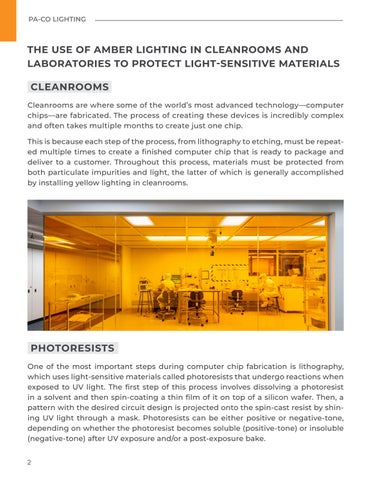PA-CO LIGHTING
THE USE OF AMBER LIGHTING IN CLEANROOMS AND LABORATORIES TO PROTECT LIGHT-SENSITIVE MATERIALS CLEANROOMS Cleanrooms are where some of the world’s most advanced technology—computer chips—are fabricated. The process of creating these devices is incredibly complex and often takes multiple months to create just one chip. This is because each step of the process, from lithography to etching, must be repeated multiple times to create a finished computer chip that is ready to package and deliver to a customer. Throughout this process, materials must be protected from both particulate impurities and light, the latter of which is generally accomplished by installing yellow lighting in cleanrooms.
PHOTORESISTS One of the most important steps during computer chip fabrication is lithography, which uses light-sensitive materials called photoresists that undergo reactions when exposed to UV light. The first step of this process involves dissolving a photoresist in a solvent and then spin-coating a thin film of it on top of a silicon wafer. Then, a pattern with the desired circuit design is projected onto the spin-cast resist by shining UV light through a mask. Photoresists can be either positive or negative-tone, depending on whether the photoresist becomes soluble (positive-tone) or insoluble (negative-tone) after UV exposure and/or a post-exposure bake. 2
